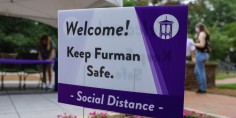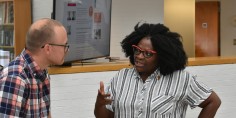Thompson has taught biology at Furman University in Greenville, S.C., since 1987. When she was hired, she was her department’s first female tenure-track professor.
“She was such an infusion of infectious energy and enthusiasm, it was like a huge breath of fresh air for me,” says former student Kimberly Chappell. “She was the first real tangible example I had of what a successful woman trained in the sciences looked like.”
Thompson was trained in plant physiology, but her focus today is ethnobotany, or the relationships between people and plants. She works in the Charles H. Townes Center for Science, which opened in 2008 after two years of construction and renovation. The Duke Endowment awarded $10 million in grants for the project.
In the center’s new food laboratory, she teaches about plants as sources of food, fiber and medicine. Students learn about tinctures and oil extracts, which they use to make soap. Outside, in her fiber and dye garden, she shows how to harvest cotton and gin it by hand. Students grow indigo, and then boil it to make dye.
Getting muddy is par for the course. “I tell them, ‘OK, we’re going out in the field. We’ve got to go pick this stuff.’ And it’s wonderful. They’re getting the direct connection between what we are teaching inside during lectures and labs and where this material comes from.”



